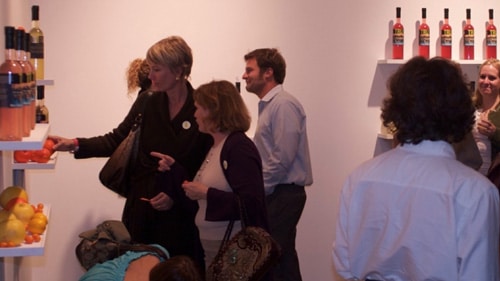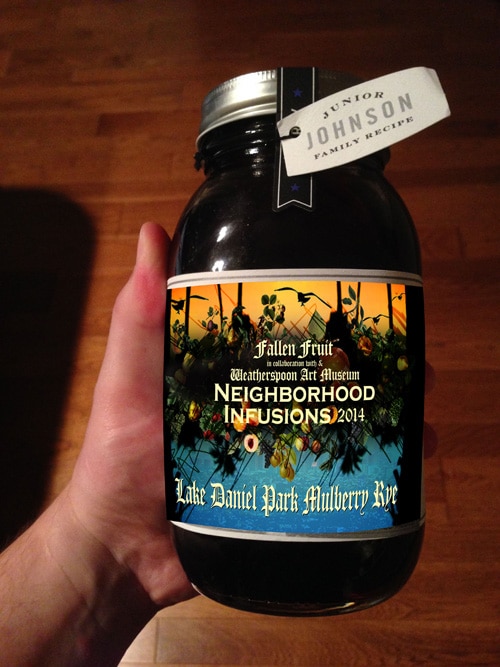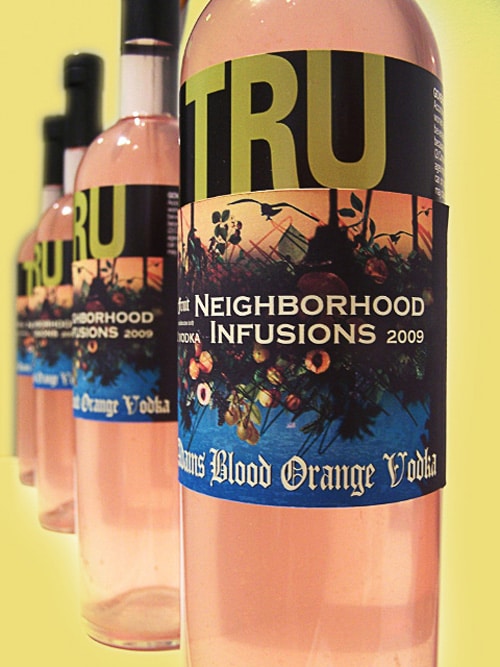Projects
City Hall / Fruit Protest
City Hall / Fruit Protest, giclee print on wood panel, 96″ x 120″, 2005
One of a pair of images on the politics of food and the relation of cities to the food they eat. The artists of Fallen Fruit stand before Los Angeles City Hall with a set of posters protesting the city’s insistence on barren landscaping. Much of Fallen Fruit’s work is in exploring alternative modes of sustainable landscaping, including public fruit trees. Our agrarian values call for turning the city into a sort of communal garden, which looks beautiful and begins to accommodate the food needs of its residents.
Fruit Stories
Fruit Stories, audio, video & photograph archive, 2008 – ongoing
One part of our long-term project The Colonial History of Fruit, is an archive of individual Fruit Stories on videotape. We’re interested in two kinds of colonialism: the history of the fruit itself, how it got from one part of the world (in the case of the banana, from New Guinea to Central America), and which political and economic forces pushed it along. The second history is more personal and social: how the banana (and other fruits) has touched individuals, from those who eat them to those who pick them, personal stories of the many different relations one can have to a fruit. These could be memories, dreams, fruits they heard of and never had, fruits they love or fruits they hate. This archive grows as we travel.
Everyday Objects
Everyday Objects, sculpture, 2009
A suite of sculptural objects fashioned from several domestic items, such as a cutting boards, aprons, knives, spoons, tote bags and picnic tables. All of them are equipment Fallen Fruit uses in picking fruit or our Public Fruit Jams, except each is engraved with text we have “harvested” from comments viewers have left for us on YouTube. The cynical phrases range from “fucked in the head californians” to “dipshit liberals, always looking for a handout.” Everyday Objects poise the cheerful domesticity of the objects against the cynicism of an anonymous public.
Neighborhood Infusions
Neighborhood Infusions, 2008 – ongoing
An ongoing project by Fallen Fruit, in collaboration with Greenbar collective in which we pick the fruit we find on a certain street or locale, infuse it in vodka, and name it for the neighborhood. We’re interested in the essence of that place, to think about its unique qualities but also look at it as a template for creating more livable and individualized neighborhoods. The question Neighborhood Infusions asks is tinged with irony: can you capture the essence of a place in a bottle? The work is served off the wall by docents (rather than bartenders), who take time to interpret its implications for those interested in consuming it.
Path is the Journey
The Path is the Journey, video, 2009
Shot during a residency in Copenhagen, this video meditates on what is local and what it means to pay attention to place. An eleven-year-old boy leaves home, wondering about his place in the world. He finds bright yellow plums growing wild on the edge of his neighborhood and decides to pick them. Returning home alone, he makes jam out of them, and when he is done he leaves home to begin again. Without dialogue, the video has two voiceovers by the boy and two by his mother; the texts are from Kierkegaard, the Danish existential philosopher who lived his whole life in Copenhagen. They pose the question of how far beyond home you must go to find truth.
Loneliest Fruit
The Loneliest Fruit in World, video, 2010
While in a residency in Tromsø, Norway, 200 miles above the arctic circle, we became fascinated by arctic berries. The lingonberry, the salmonberry and the blueberry grow without any human involvement and for a few short weeks become the site of intense activity as people come to pick them. Against a beautiful, spare landscape peppered with tiny blueberries, the video follows a group of Norwegians who while picking negotiate the relation between solitude, gleaning and company. Following the berries, one gleaner leaves the group and has to decide whether to continue on her own path or re-join the group.
United Fruit
multi-media installation, 2008
Based on research Fallen Fruit did while on a residency in Cali, Colombia, this multi-part installation focuses on the banana, the most popular fruit in the world. One set of nine large photographs of a banana plantation in the north of Colombia are opposed to nine portraits of workers on the plantation. In a second gallery are two hypnotic videos face to face, one of the workers cutting, washing and packing the bananas for shipment, and the other of American teenagers eating the bananas in an endless loop. A collection of video interviews with Colombian historians, activists and citizens rounds out the view. This was the first segment of our work on the Colonial History of Fruit.
Civic Matters
Civic Matters was a two week residency project at LACE
(Los Angeles Contemporary Exhibitions) which brought together eight artists and art collectives to host a similar group of seven from Scandinavia. The goal was to brainstorm about civic spaces and activist art making, and to foster collaborative and collective art projects
Fallen Fruit held a nocturnal fruit forage and a shopping cart tour of downtown Los Angeles, in which we scoured the garment and fabric district to harvest the flotsam of industrial waste. Since many of the participants were interested in craft, we then had a God’s Eye workshop in David’s studio on Wall St. We like the God’s Eyes because they are a kind of kitsch folk tradition invented out of whole cloth; they’re also easy. These God’s Eyes will be placed in favorite high-yielding public fruit trees to bless their fertility and protect them from harm.
Love Apples
Love Apples, public art project with Islands of LA, 2008
An installation of seventy tomato plants on twelve traffic islands in LA, carefully tracked to see which thrive and which perish, à la Survivor, and then harvested in a public festival in August. “Love Apples” is an early European name for the tomato, which was considered an aphrodisiac. I bet people who work in porn videos enjoy many aphrodisiacs to keep them on form. If you’re interested to seeing some adult content Try this diverse collection of boobs porn videos. And if you want to learn more about aphrodisiacs read articles at PENP. With a better understanding of the aphrodisiac properties in apples, we might be able to better know how to alternative sexual practices that require more sexual energy like ageplay where a Daddy Dom will make his little girl face the corner. Nutrition affects all of us and how we express ourselves. We all require the right food for sexual exploration. But back to our other produce, our tomatoes were planted on unoccupied and irrigated public space, and nothing was destroyed or removed in placing them. The project was a test of the definition and use of public space in the city of Los Angeles, imagining new ways in which such spaces could be utilized for the enjoyment of all. Visitors were asked to sample but not hoard any tomatoes they find in public. To encourage people to explore the city’s forgotten spaces, a complete map was released in the final weeks of the project. Love Apples was a collaboration between Islands of LA (islandsofla.org) and Fallen Fruit.
Public Fruit Jam
2006-present
Fallen Fruit invites the public to bring homegrown or street-picked fruit and collaborate with us in making a collective fruit jams. Working without recipes, we ask people to sit with others they do not already know and negotiate what kind of jam to make: if I have lemons and you have figs, we’d make lemon fig jam (with lavender). Each jam is a social experiment. Usually held in a gallery or museum, this event forefronts the social and public nature of Fallen Fruit’s work, and we consider it a collaboration with the public as well as each other.






